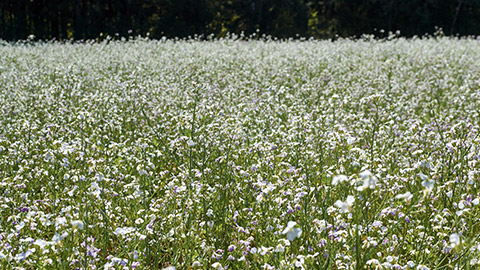Now that we know what soil is made of and we understand its properties, we’re going to explore some activities we can take to look after our soil.
As we have learned, soil is so much more than dirt. A grower who cultivates healthy soil is rewarded with a nurturing ecosystem to support plant life.
Chapter 3: Our Activities and Their Effects 2021Soil health is a soil’s ongoing capacity to function as a living ecosystem that sustains plant, animal, and human health. Therefore, healthy soils are those that are rich in biodiversity – ones with an extensive soil food web.
You probably know what healthy soils look, feel, and smell like.
When we dig into it, or open it up with a garden fork:
- we see lots of worms
- it breaks apart easily (it's friable)
- it's dark brown
- it's moist
- it smells almost sweet
- you might see mycelia networks.
Looking around at the plants growing in it, you’ll also see plants thriving. This is because the right nutrients are in the soil and are being made plant available.
You might feel it in your gut; your instinct may tell you it’s healthy. If you are so inclined, you might even sense its wairua (spirit) and mauri (life force).
If your plants don’t look great, but your soil does, chances are the issue is not related to soil health. It could be to do with water management or other cultivation practices.
If your soil doesn’t seem healthy, try and diagnose what it's lacking. If you’re not sure, carry out some tests or send soil samples off to the lab for testing.

Radish (Raphanus sativus) is a popular cover crop in New Zealand, known for its deep root system that can penetrate up to one metre into the soil. This helps to break up compacted soil, improve soil structure, and increase nutrient availability.
What is a soil food web?
Bragato Research Institute, What’s the soil food web?Soil without biology is dirt. Soil biological interactions are referred to as the soil food web. The soil food web describes how groups of organisms in soil interact with each other and plants.
In the previous subtopic, we described how you could augment mature soil. But, if you are starting from a bare soil, and your soil food web is still developing, here are some things that can help you build healthy soil:
- Increase the amount of air in the soil (unless your soil is already highly permeable, such as a sandy soil).
- To do this manually, use a garden fork to penetrate deep into the soil then pull back to crack the soil open.
- Alternatively, plant crops and cover crops that penetrate deep into the soil. When these die off the roots will decompose and the channels they have created will remain, leaving space for air. The image above shows how radish is commonly used this way in New Zealand.
- Add gypsum to soils with a high clay content. Gypsum helps to break up clay soil by binding with the clay particles and loosening the soil.
- Add organic matter.
- Adding aged compost or manure will add nutrients without the need for synthetic fertilisers.
- Adding organic matter also helps retain soil moisture and makes the environment more attractive to earthworms.
- Organic matter can also heal and break up clay soils.
- Inoculate your soil.
- If you want to speed up the process of forming a well-developed soil food web, you can add beneficial fungi and bacteria directly, for example, Seacliff Organics’ NZ native mycorrhizal fungi.

When we have regenerated our soil back to healthiness, we must look after it.
Go by the rule of (green) thumb that it's easier to keep your soil healthy than bring it back to good health.
These tips will help keep your soil dark brown, supporting rich biodiversity, aerated, and nutritive:
- Control weeds only in areas where it matters — where they will compete with your crops. If they grow in your lawn, only control them if they create a problem, such as prickles.
- When weeds first appear in your garden beds, cultivate (mix up) the top few centimetres of the soil, using a hoe. This way, the deeper parts of the soil are unaffected, but the weeds are destroyed before they get too big.
- If it is hot and dry, leave the weeds on the soil. They will quickly die, decompose, and in doing so add more nutrients to the soil.
- By breaking up the topsoil, water can penetrate the soil more easily.
- If weeds get away on you and become really big, cut them off just below the surface.
- This should kill them. By leaving the roots there, they will decompose in the soil and leave pore space for air and water.
- Don’t pull the roots out. Pulling out a large root systems will disturb a significant amount of the soil food web.
- Continue to add organic matter regularly. As plants draw nutrients from the soil to enable them to grow, less of those nutrients are left in the soil.
- Add organic matter once per growing season.
- When preparing to grow plants that use lots of nutrients – often called gross feeders – add more organic matter.
- Let the biology of the soil do its work. These processes have been forming excellent soils for millions, if not billions, of years.
Because our soil is precious, we should protect it. While we are maintaining the soil, we also need to protect soil from threats, such as it getting too dry or compacted.
There are several things we can do to help keep soil safe, such as:
- Circulate on walking paths wherever possible.
- Do not walk on garden beds if at all possible.
- If using machinery, use machines that can operate from the pathways, or opt for lightweight machinery if you need to drive it in the growing areas.
- Use a minimum tillage approach.
- In the case of forming raised beds, turn over the soil once with spades, a rotary hoe, or a plough to form the beds.
- After that, only cultivate the top few centimetres when weeding or mixing in amendments.
- If tilling, wait until the soil is ready. It mustn’t be too wet, or too dry. If you’re not sure, dig up a small area and grab some soil in your hand. It shouldn’t feel muddy, dry, or dusty.
- Water your plants and soil only when you need to.
- Water infrequently but deeply. This helps encourage plant roots to grow deeper which means they are able to draw water out of a larger volume of soil.
- This helps improve their ability to cope with long dry spells.
- It also helps aerate the soil.
- Grow cover crops. Never leave soil bare for an extended period of time. Bare soil is prone to erosion and will quickly be filled in by nature’s choice of plants —ones you’ll probably consider as weeds.
- By seeding fast-growing crops on bare soil, you quickly limit erosion.
- Wherever possible, plant native plants in areas of bare soil that you don’t need for other uses. These plants are the most well adapted to our climate, as they’ve evolved to this environment. This is sometimes called “recloaking Papatuanuku.”
- If you grow cover crops in your garden beds over winter, you can tarp these in early spring and when the dead plant material breaks down, the nutrients will be returned to the soil. This is known as a green manure. This process can be sped up by mowing the plants down to chop them into small pieces before tarping.

▶ Market Gardener's Toolkit (optional)
JM Fortier talks about how they use cover crops to reduce soil erosion and to increase the nutrients in the soil. The same approach can be applied to a smaller scale using a standard lawnmower or line trimmer to cut the crop down before tarping.
| Heading | Using cover crops for green manure |
| Timestamp | 25:00 — 31:00 |
Activity – Maintain and protect your soil quiz
Answer the following six questions and see how much you remember about keeping your soil healthy.
